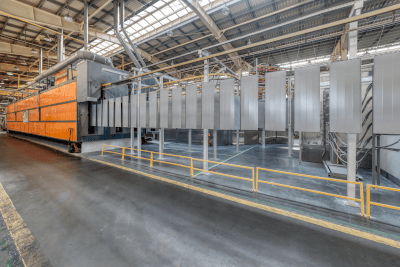What Is an Electrostatic Coating Machine?

An electrostatic coating machine is a mass-production paint equipment that performs electrostatic coating, a coating method that uses high-voltage direct current. Electrostatic coating itself has a long history, dating back to the 1930s.
Compared to atomizing coating, where paint is sprayed as a mist, dipping, where paint is immersed in a bath of paint, and pressing-type coating, where paint is applied with a roller or brush, electrostatic coating requires less paint and does not generate air bubbles. This results in a lack of pinholes in the paint film. However, dust and dirt are attracted by static electricity, leading to the need to watch out for “dust and dirt spots,” which are defects in the paint film. Additionally, due to the use of electricity, fire hazards must be carefully managed.
Uses of Electrostatic Coating Machines
Electrostatic coating machines are used not only for mass-produced general-purpose products but also for industrial applications such as automobile painting, as they can efficiently apply a coating film to the object being painted.
Electrostatic coating allows the paint to adhere to the object in a way that atomizing coating cannot achieve, simplifying the process. It has the advantage of being applicable even to areas such as corners where compressed air cannot reach.
While a uniform coating film is achieved, one drawback is that the paint tends to accumulate on convex areas where the electric field is concentrated. Because of the use of electric current, organic solvent-based paints are more suitable than water-based paints.
Principles of Electrostatic Coating Machines
Electrostatic coating machines utilize electrostatic stress as their defining principle. Electrostatic stress refers to the phenomenon in which, when one of the electrodes or the object to be coated is grounded and brought close to the discharge electrode of the coating machine, the electrode opposite to the discharge electrode becomes charged.
When the object to be coated is grounded and a negative electrode is applied, the object becomes positively charged. Increasing the voltage of the discharge electrode of the coating machine causes corona discharge, ionizing the surrounding air and generating an ion current from the discharge electrode to the coated object. The coating droplets in the coater also become charged and are attracted to the coated object by the ionic current, adhering to it, losing their charge, and becoming fixed in place.
By incorporating an air sprayer into the discharge electrode of the coating machine, the paint can be made finer, and the paint droplets can be charged in a shorter time, reducing working time. If a stationary type is used, it is necessary to be vigilant about changes in viscosity due to rising paint film temperatures caused by elevated temperatures and reductions in electrostatic effects due to contamination.
On the other hand, when used handheld, skilled work is required to prevent sparking phenomena when the distance between the electrostatic coating machine and the object to be coated becomes too close.
Disadvantages of Electrostatic Coating Machines
Electrostatic coating can efficiently form a coating film for a large quantity and small variety of products, which is a major advantage. However, the use of static electricity and powder can pose disadvantages.
Uneven Coating and Unique Defects
Electrostatic coating relies on electrostatic stress, so if the shape of the coated object is not uniform, the electric field will be non-uniform, resulting in unevenness. The electric field tends to concentrate on convex areas, causing paint to accumulate there and leading to thicker coatings than on other areas.
Dust and dirt in the atmosphere are also attracted by static electricity, resulting in paint defects known as “dust and dirt spots.” Another defect can occur due to reverse ionization when the voltage is too high.
Achieving Thin Film Thickness Is Difficult
Electrostatic coating machines cannot produce thin films because powder is applied directly as a coating material. The minimum coating thickness is about 30 μm, and attempting to make the coating film thinner can easily result in defects, such as unevenness, necessitating a switch to liquid coating methods, like organic solvent coating.
Challenges in Small-Quantity, High-Variety Production
Electrostatic coating is a lengthy and complex process involving cleaning before coating, paint adhesion, and high-temperature baking drying.
Specialized Coating Equipment and Safety Measures Required
The use of high-voltage electricity and powder demands dedicated coating equipment with safety measures against electric shock and fire, resulting in significant initial investment costs. Apart from coating equipment, drying ovens and other equipment for fixing the coating film and for pre-coating processes to remove oil and rust are also required, presenting another disadvantage.
Management of Paint Powder
As the paint is in powder form, safety measures against dust explosions are crucial, not only during use but also during storage. Powders have a large surface area and are susceptible to oxidation and contamination, potentially leading to defects.
Difference Between Electrostatic and Electrodeposition Coating
The main difference between electrostatic and electrodeposition coating lies in their methods. Electrostatic coating sprays paint and utilizes electrolysis to make the paint adhere, while electrodeposition coating involves immersing the coated object in a paint bath and applying an electric current to deposit a film. Electrodeposition coating is known for its high coating uniformity due to immersion in liquid paint.